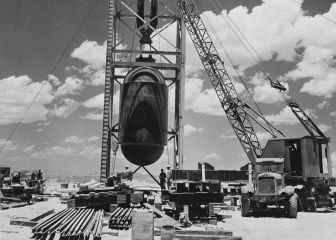The Manhattan Project, coined by the president of the United States, Franklin D. Roosevelt, emerged to name a key project for the configuration of a nuclear bomb during the beginning of World War II. However, the pioneer of this plan was Albert Einsteinone of the most important scientists and physicists of the 20th century, since he conveyed to the American leader the possibility that the German side would use the energy released due to nuclear fission for the production of bombs of this caliber.
In addition, scientists with great names in world society participated in this project, such as physicists Enrico Fermi, Leo Szilard and Robert Oppenheimer, considered “the father of the atomic bomb” as the director of the project, as well as the Hungarian mathematician John Von Neumann. Also, Canada and the United Kingdom developed the project in several research centers. Years later, the Manhattan Project had more than 130,000 scientists behind it.
Why was it called the ‘Manhattan Project’?
The United States War Department joined the S-1 Committee through the Army Corps of Engineerswhich was the largest public engineering body in the world, according to The vanguard. Since most of the nuclear research had been carried out at the University of Columbialocated in Manhattan, the professionals of this district were put in command and thus the name of the project was born.
Robert Oppenheimer, the leader of the operation
The most prominent scientist in the creation of atomic bombs was the American Robert Oppenheimer. A theoretical physicist by profession, Oppenheimer was the director of the Manhattan project and commissioned to develop a nuclear weapon before Germany did. Thus, the first atomic bomb in history was developed by Oppenheimer and a controlled detonation was carried out in the New Mexico desert on July 16, 1945, one month before the launch of the Hiroshima and Nagasaki bombs. The proof Trinity It was the first test of a nuclear weapon by the United States.
The Manhattan Project had a budget of two billion dollars with which infrastructures would be built and the rest of the project would be developed. The laboratory in which the bomb was built was located in a isolated place in New Mexico, near Santa Fe.
The year 1945 was key for the Manhattan Project. On April 12, Franklin D. Roosevelt died, and his successor, Harry Truman, did not learn of the project’s existence until shortly before his inauguration. Hitler took his own life on April 30 in a Berlin bunker and eight days later, Germany surrendered. With such a favorable scenario for the Americans, Many wondered what was the point of continuing with the project.
Some scientists asked that the bomb not be dropped on Hiroshima
World War II was continuing in the Pacific, and US forces had chosen seventeen possible targets in Japan to drop the atomic bomb on. Leo Szilard, another of the project scientists, promoted the Frank Reportin which the president of the United States was asked Don’t use the atomic bomb.
The petition never worked, and on August 6, 1945, the bomber Enola Gay dropped the atomic bomb. about hiroshima city. The operation ended with 70,000 deadand almost twice as many people would later die from the radiation.
